Project Management Online Exam: Stakeholder & Project Management
VerifiedAdded on 2023/06/15
|15
|3332
|433
Report
AI Summary
This document provides a comprehensive solution to an online exam in project management. It covers key areas such as project handover planning, including instructions, status reports, checklists, and stakeholder introductions. The document also details the five phases of commissioning plans: pre-design, design, construction, acceptance, and post-acceptance, highlighting the importance of communication and coordination. Furthermore, it discusses stakeholder management, emphasizing the identification, classification, and engagement of stakeholders in construction projects, along with risk management strategies. Finally, the solution contrasts the roles and duties of generalist and specialist project managers, underscoring the necessity of both skill sets for project success. This resource is available on Desklib, a platform offering a wealth of study materials for students.
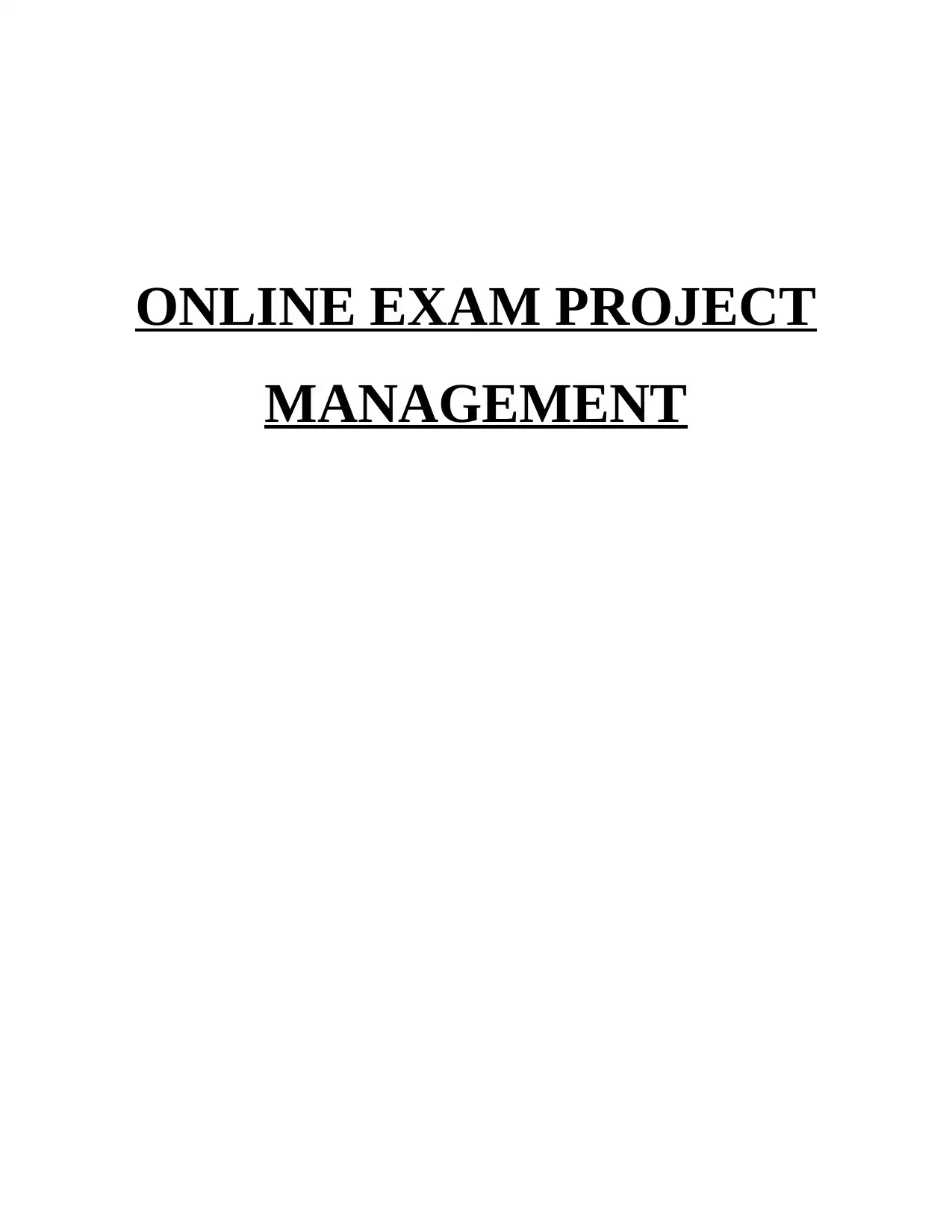
ONLINE EXAM PROJECT
MANAGEMENT
MANAGEMENT
Paraphrase This Document
Need a fresh take? Get an instant paraphrase of this document with our AI Paraphraser
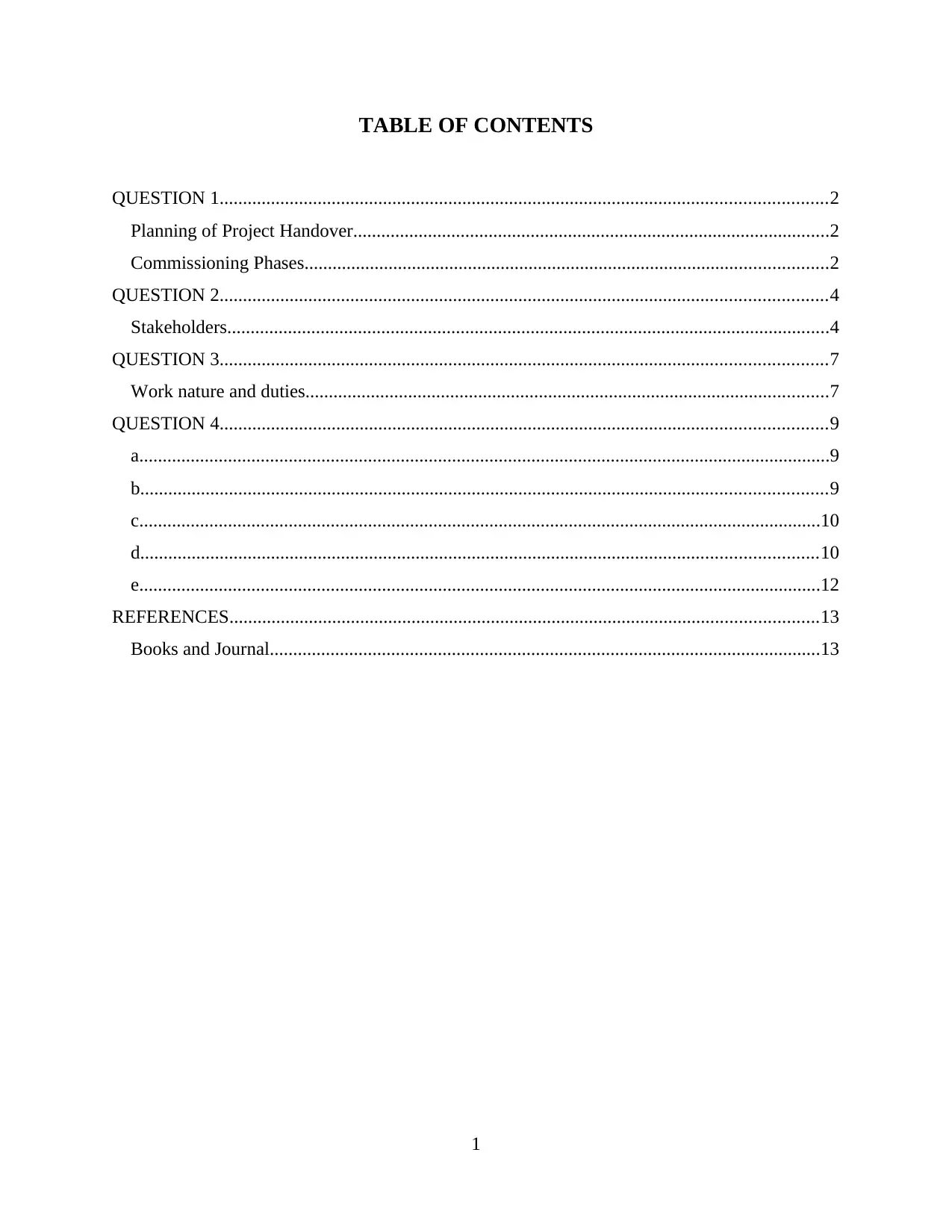
TABLE OF CONTENTS
QUESTION 1..................................................................................................................................2
Planning of Project Handover......................................................................................................2
Commissioning Phases................................................................................................................2
QUESTION 2..................................................................................................................................4
Stakeholders.................................................................................................................................4
QUESTION 3..................................................................................................................................7
Work nature and duties................................................................................................................7
QUESTION 4..................................................................................................................................9
a....................................................................................................................................................9
b...................................................................................................................................................9
c..................................................................................................................................................10
d.................................................................................................................................................10
e..................................................................................................................................................12
REFERENCES..............................................................................................................................13
Books and Journal......................................................................................................................13
1
QUESTION 1..................................................................................................................................2
Planning of Project Handover......................................................................................................2
Commissioning Phases................................................................................................................2
QUESTION 2..................................................................................................................................4
Stakeholders.................................................................................................................................4
QUESTION 3..................................................................................................................................7
Work nature and duties................................................................................................................7
QUESTION 4..................................................................................................................................9
a....................................................................................................................................................9
b...................................................................................................................................................9
c..................................................................................................................................................10
d.................................................................................................................................................10
e..................................................................................................................................................12
REFERENCES..............................................................................................................................13
Books and Journal......................................................................................................................13
1

2
⊘ This is a preview!⊘
Do you want full access?
Subscribe today to unlock all pages.

Trusted by 1+ million students worldwide
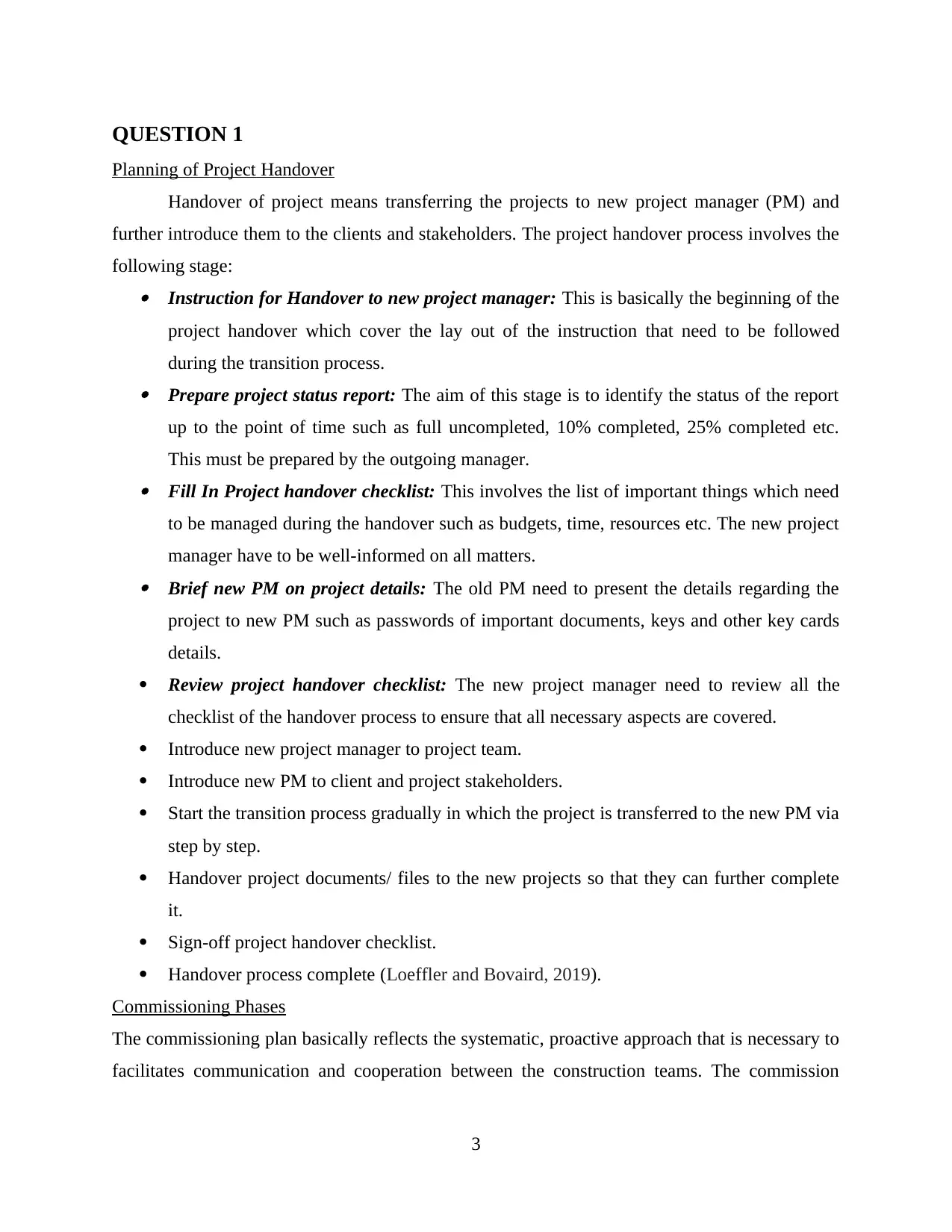
QUESTION 1
Planning of Project Handover
Handover of project means transferring the projects to new project manager (PM) and
further introduce them to the clients and stakeholders. The project handover process involves the
following stage: Instruction for Handover to new project manager: This is basically the beginning of the
project handover which cover the lay out of the instruction that need to be followed
during the transition process. Prepare project status report: The aim of this stage is to identify the status of the report
up to the point of time such as full uncompleted, 10% completed, 25% completed etc.
This must be prepared by the outgoing manager. Fill In Project handover checklist: This involves the list of important things which need
to be managed during the handover such as budgets, time, resources etc. The new project
manager have to be well-informed on all matters. Brief new PM on project details: The old PM need to present the details regarding the
project to new PM such as passwords of important documents, keys and other key cards
details.
Review project handover checklist: The new project manager need to review all the
checklist of the handover process to ensure that all necessary aspects are covered.
Introduce new project manager to project team.
Introduce new PM to client and project stakeholders.
Start the transition process gradually in which the project is transferred to the new PM via
step by step.
Handover project documents/ files to the new projects so that they can further complete
it.
Sign-off project handover checklist.
Handover process complete (Loeffler and Bovaird, 2019).
Commissioning Phases
The commissioning plan basically reflects the systematic, proactive approach that is necessary to
facilitates communication and cooperation between the construction teams. The commission
3
Planning of Project Handover
Handover of project means transferring the projects to new project manager (PM) and
further introduce them to the clients and stakeholders. The project handover process involves the
following stage: Instruction for Handover to new project manager: This is basically the beginning of the
project handover which cover the lay out of the instruction that need to be followed
during the transition process. Prepare project status report: The aim of this stage is to identify the status of the report
up to the point of time such as full uncompleted, 10% completed, 25% completed etc.
This must be prepared by the outgoing manager. Fill In Project handover checklist: This involves the list of important things which need
to be managed during the handover such as budgets, time, resources etc. The new project
manager have to be well-informed on all matters. Brief new PM on project details: The old PM need to present the details regarding the
project to new PM such as passwords of important documents, keys and other key cards
details.
Review project handover checklist: The new project manager need to review all the
checklist of the handover process to ensure that all necessary aspects are covered.
Introduce new project manager to project team.
Introduce new PM to client and project stakeholders.
Start the transition process gradually in which the project is transferred to the new PM via
step by step.
Handover project documents/ files to the new projects so that they can further complete
it.
Sign-off project handover checklist.
Handover process complete (Loeffler and Bovaird, 2019).
Commissioning Phases
The commissioning plan basically reflects the systematic, proactive approach that is necessary to
facilitates communication and cooperation between the construction teams. The commission
3
Paraphrase This Document
Need a fresh take? Get an instant paraphrase of this document with our AI Paraphraser
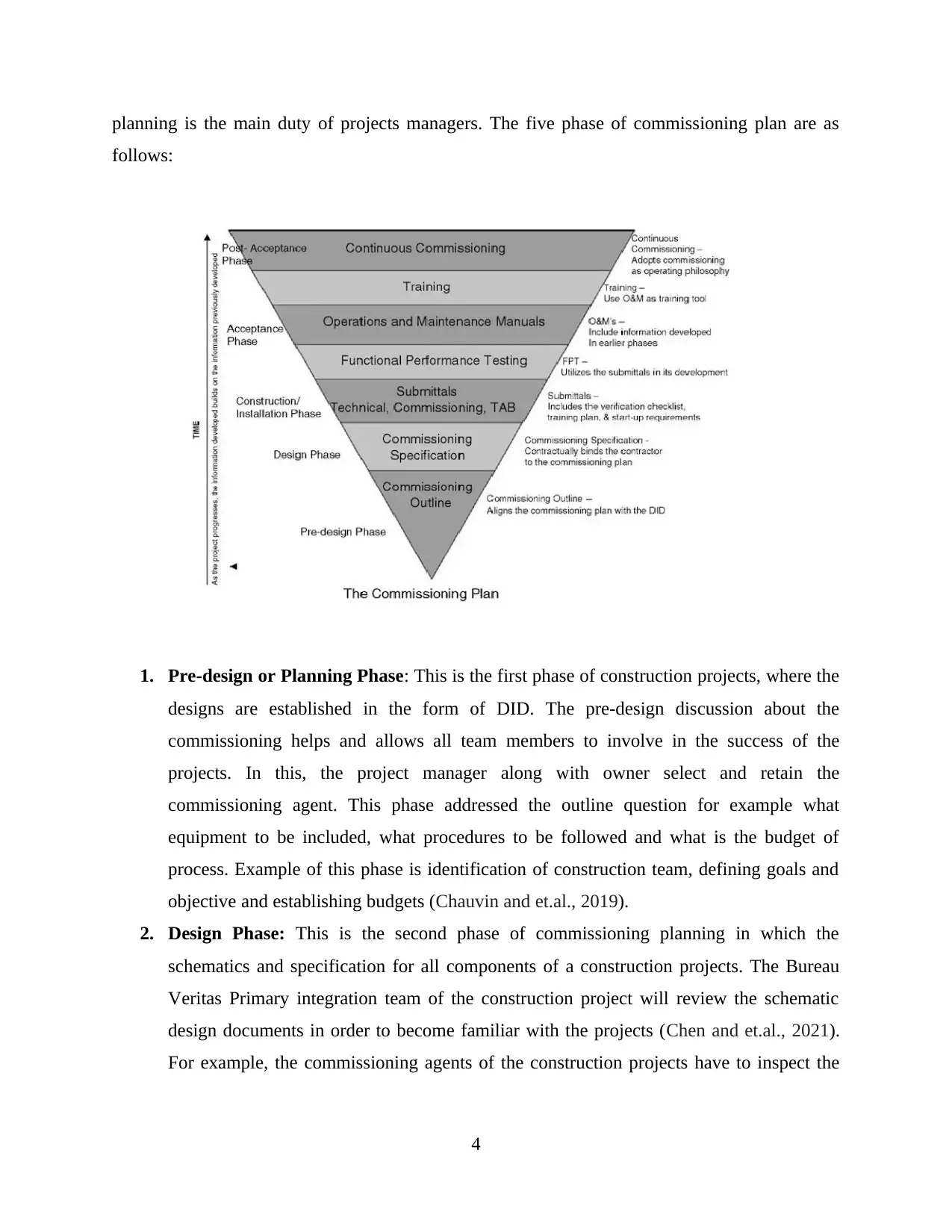
planning is the main duty of projects managers. The five phase of commissioning plan are as
follows:
1. Pre-design or Planning Phase: This is the first phase of construction projects, where the
designs are established in the form of DID. The pre-design discussion about the
commissioning helps and allows all team members to involve in the success of the
projects. In this, the project manager along with owner select and retain the
commissioning agent. This phase addressed the outline question for example what
equipment to be included, what procedures to be followed and what is the budget of
process. Example of this phase is identification of construction team, defining goals and
objective and establishing budgets (Chauvin and et.al., 2019).
2. Design Phase: This is the second phase of commissioning planning in which the
schematics and specification for all components of a construction projects. The Bureau
Veritas Primary integration team of the construction project will review the schematic
design documents in order to become familiar with the projects (Chen and et.al., 2021).
For example, the commissioning agents of the construction projects have to inspect the
4
follows:
1. Pre-design or Planning Phase: This is the first phase of construction projects, where the
designs are established in the form of DID. The pre-design discussion about the
commissioning helps and allows all team members to involve in the success of the
projects. In this, the project manager along with owner select and retain the
commissioning agent. This phase addressed the outline question for example what
equipment to be included, what procedures to be followed and what is the budget of
process. Example of this phase is identification of construction team, defining goals and
objective and establishing budgets (Chauvin and et.al., 2019).
2. Design Phase: This is the second phase of commissioning planning in which the
schematics and specification for all components of a construction projects. The Bureau
Veritas Primary integration team of the construction project will review the schematic
design documents in order to become familiar with the projects (Chen and et.al., 2021).
For example, the commissioning agents of the construction projects have to inspect the
4
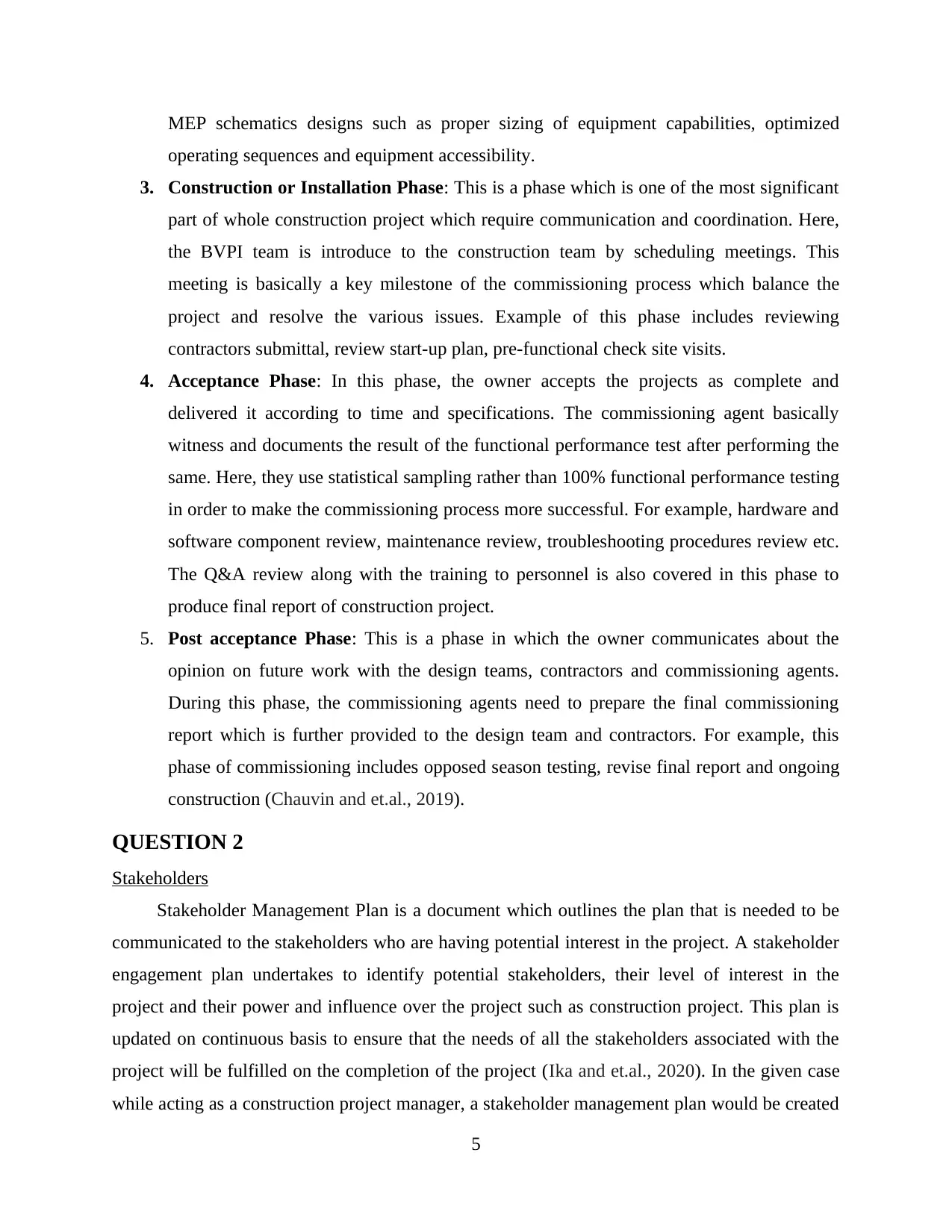
MEP schematics designs such as proper sizing of equipment capabilities, optimized
operating sequences and equipment accessibility.
3. Construction or Installation Phase: This is a phase which is one of the most significant
part of whole construction project which require communication and coordination. Here,
the BVPI team is introduce to the construction team by scheduling meetings. This
meeting is basically a key milestone of the commissioning process which balance the
project and resolve the various issues. Example of this phase includes reviewing
contractors submittal, review start-up plan, pre-functional check site visits.
4. Acceptance Phase: In this phase, the owner accepts the projects as complete and
delivered it according to time and specifications. The commissioning agent basically
witness and documents the result of the functional performance test after performing the
same. Here, they use statistical sampling rather than 100% functional performance testing
in order to make the commissioning process more successful. For example, hardware and
software component review, maintenance review, troubleshooting procedures review etc.
The Q&A review along with the training to personnel is also covered in this phase to
produce final report of construction project.
5. Post acceptance Phase: This is a phase in which the owner communicates about the
opinion on future work with the design teams, contractors and commissioning agents.
During this phase, the commissioning agents need to prepare the final commissioning
report which is further provided to the design team and contractors. For example, this
phase of commissioning includes opposed season testing, revise final report and ongoing
construction (Chauvin and et.al., 2019).
QUESTION 2
Stakeholders
Stakeholder Management Plan is a document which outlines the plan that is needed to be
communicated to the stakeholders who are having potential interest in the project. A stakeholder
engagement plan undertakes to identify potential stakeholders, their level of interest in the
project and their power and influence over the project such as construction project. This plan is
updated on continuous basis to ensure that the needs of all the stakeholders associated with the
project will be fulfilled on the completion of the project (Ika and et.al., 2020). In the given case
while acting as a construction project manager, a stakeholder management plan would be created
5
operating sequences and equipment accessibility.
3. Construction or Installation Phase: This is a phase which is one of the most significant
part of whole construction project which require communication and coordination. Here,
the BVPI team is introduce to the construction team by scheduling meetings. This
meeting is basically a key milestone of the commissioning process which balance the
project and resolve the various issues. Example of this phase includes reviewing
contractors submittal, review start-up plan, pre-functional check site visits.
4. Acceptance Phase: In this phase, the owner accepts the projects as complete and
delivered it according to time and specifications. The commissioning agent basically
witness and documents the result of the functional performance test after performing the
same. Here, they use statistical sampling rather than 100% functional performance testing
in order to make the commissioning process more successful. For example, hardware and
software component review, maintenance review, troubleshooting procedures review etc.
The Q&A review along with the training to personnel is also covered in this phase to
produce final report of construction project.
5. Post acceptance Phase: This is a phase in which the owner communicates about the
opinion on future work with the design teams, contractors and commissioning agents.
During this phase, the commissioning agents need to prepare the final commissioning
report which is further provided to the design team and contractors. For example, this
phase of commissioning includes opposed season testing, revise final report and ongoing
construction (Chauvin and et.al., 2019).
QUESTION 2
Stakeholders
Stakeholder Management Plan is a document which outlines the plan that is needed to be
communicated to the stakeholders who are having potential interest in the project. A stakeholder
engagement plan undertakes to identify potential stakeholders, their level of interest in the
project and their power and influence over the project such as construction project. This plan is
updated on continuous basis to ensure that the needs of all the stakeholders associated with the
project will be fulfilled on the completion of the project (Ika and et.al., 2020). In the given case
while acting as a construction project manager, a stakeholder management plan would be created
5
⊘ This is a preview!⊘
Do you want full access?
Subscribe today to unlock all pages.

Trusted by 1+ million students worldwide
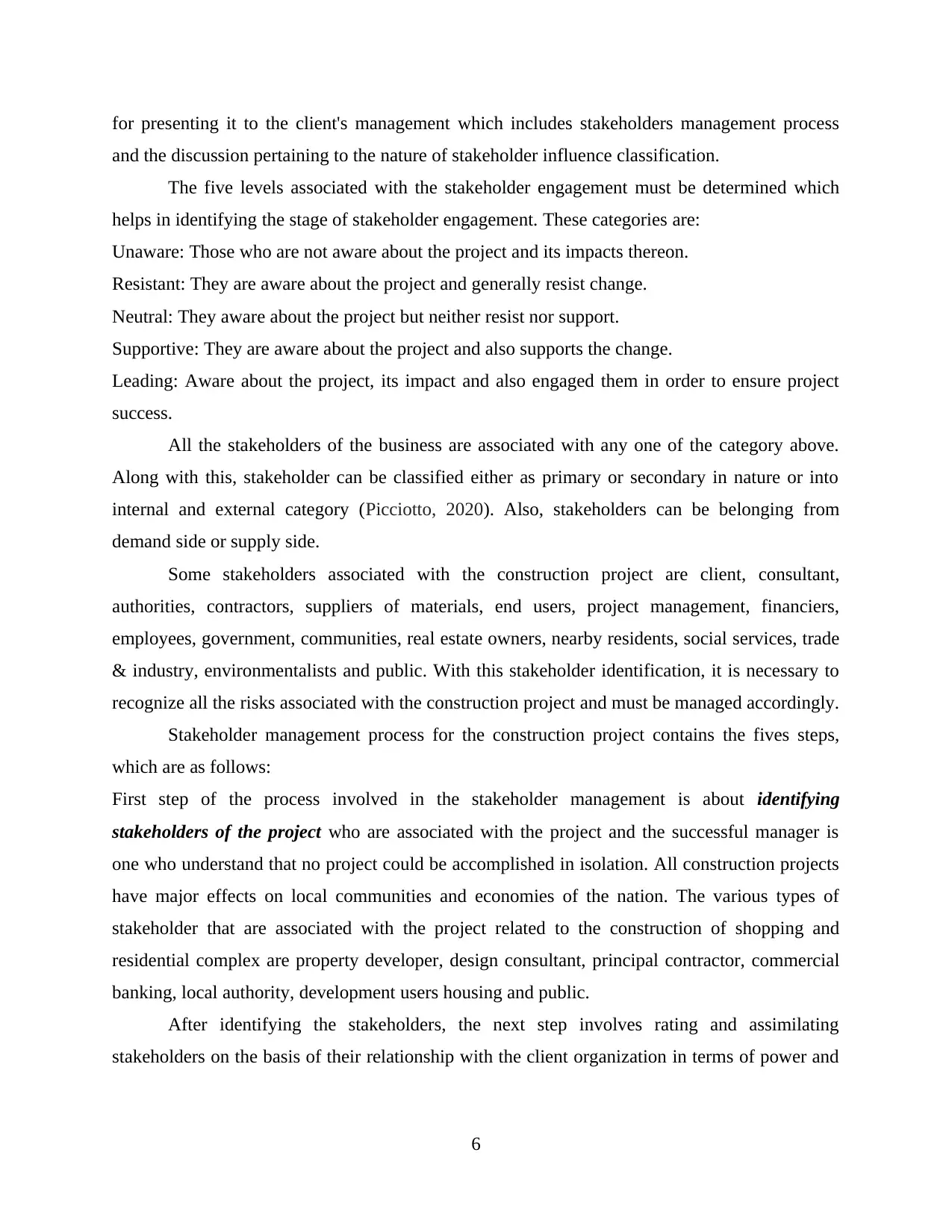
for presenting it to the client's management which includes stakeholders management process
and the discussion pertaining to the nature of stakeholder influence classification.
The five levels associated with the stakeholder engagement must be determined which
helps in identifying the stage of stakeholder engagement. These categories are:
Unaware: Those who are not aware about the project and its impacts thereon.
Resistant: They are aware about the project and generally resist change.
Neutral: They aware about the project but neither resist nor support.
Supportive: They are aware about the project and also supports the change.
Leading: Aware about the project, its impact and also engaged them in order to ensure project
success.
All the stakeholders of the business are associated with any one of the category above.
Along with this, stakeholder can be classified either as primary or secondary in nature or into
internal and external category (Picciotto, 2020). Also, stakeholders can be belonging from
demand side or supply side.
Some stakeholders associated with the construction project are client, consultant,
authorities, contractors, suppliers of materials, end users, project management, financiers,
employees, government, communities, real estate owners, nearby residents, social services, trade
& industry, environmentalists and public. With this stakeholder identification, it is necessary to
recognize all the risks associated with the construction project and must be managed accordingly.
Stakeholder management process for the construction project contains the fives steps,
which are as follows:
First step of the process involved in the stakeholder management is about identifying
stakeholders of the project who are associated with the project and the successful manager is
one who understand that no project could be accomplished in isolation. All construction projects
have major effects on local communities and economies of the nation. The various types of
stakeholder that are associated with the project related to the construction of shopping and
residential complex are property developer, design consultant, principal contractor, commercial
banking, local authority, development users housing and public.
After identifying the stakeholders, the next step involves rating and assimilating
stakeholders on the basis of their relationship with the client organization in terms of power and
6
and the discussion pertaining to the nature of stakeholder influence classification.
The five levels associated with the stakeholder engagement must be determined which
helps in identifying the stage of stakeholder engagement. These categories are:
Unaware: Those who are not aware about the project and its impacts thereon.
Resistant: They are aware about the project and generally resist change.
Neutral: They aware about the project but neither resist nor support.
Supportive: They are aware about the project and also supports the change.
Leading: Aware about the project, its impact and also engaged them in order to ensure project
success.
All the stakeholders of the business are associated with any one of the category above.
Along with this, stakeholder can be classified either as primary or secondary in nature or into
internal and external category (Picciotto, 2020). Also, stakeholders can be belonging from
demand side or supply side.
Some stakeholders associated with the construction project are client, consultant,
authorities, contractors, suppliers of materials, end users, project management, financiers,
employees, government, communities, real estate owners, nearby residents, social services, trade
& industry, environmentalists and public. With this stakeholder identification, it is necessary to
recognize all the risks associated with the construction project and must be managed accordingly.
Stakeholder management process for the construction project contains the fives steps,
which are as follows:
First step of the process involved in the stakeholder management is about identifying
stakeholders of the project who are associated with the project and the successful manager is
one who understand that no project could be accomplished in isolation. All construction projects
have major effects on local communities and economies of the nation. The various types of
stakeholder that are associated with the project related to the construction of shopping and
residential complex are property developer, design consultant, principal contractor, commercial
banking, local authority, development users housing and public.
After identifying the stakeholders, the next step involves rating and assimilating
stakeholders on the basis of their relationship with the client organization in terms of power and
6
Paraphrase This Document
Need a fresh take? Get an instant paraphrase of this document with our AI Paraphraser
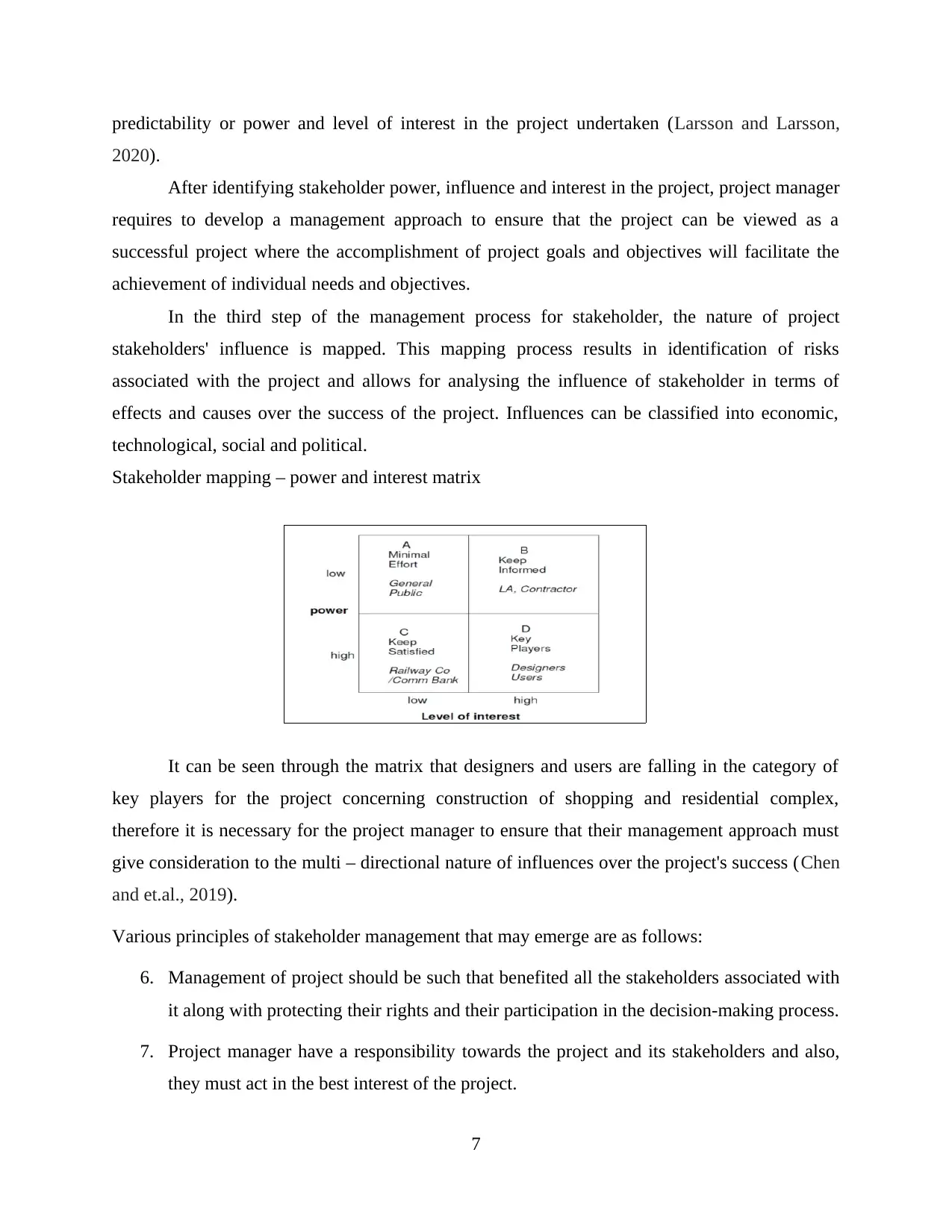
predictability or power and level of interest in the project undertaken (Larsson and Larsson,
2020).
After identifying stakeholder power, influence and interest in the project, project manager
requires to develop a management approach to ensure that the project can be viewed as a
successful project where the accomplishment of project goals and objectives will facilitate the
achievement of individual needs and objectives.
In the third step of the management process for stakeholder, the nature of project
stakeholders' influence is mapped. This mapping process results in identification of risks
associated with the project and allows for analysing the influence of stakeholder in terms of
effects and causes over the success of the project. Influences can be classified into economic,
technological, social and political.
Stakeholder mapping – power and interest matrix
It can be seen through the matrix that designers and users are falling in the category of
key players for the project concerning construction of shopping and residential complex,
therefore it is necessary for the project manager to ensure that their management approach must
give consideration to the multi – directional nature of influences over the project's success (Chen
and et.al., 2019).
Various principles of stakeholder management that may emerge are as follows:
6. Management of project should be such that benefited all the stakeholders associated with
it along with protecting their rights and their participation in the decision-making process.
7. Project manager have a responsibility towards the project and its stakeholders and also,
they must act in the best interest of the project.
7
2020).
After identifying stakeholder power, influence and interest in the project, project manager
requires to develop a management approach to ensure that the project can be viewed as a
successful project where the accomplishment of project goals and objectives will facilitate the
achievement of individual needs and objectives.
In the third step of the management process for stakeholder, the nature of project
stakeholders' influence is mapped. This mapping process results in identification of risks
associated with the project and allows for analysing the influence of stakeholder in terms of
effects and causes over the success of the project. Influences can be classified into economic,
technological, social and political.
Stakeholder mapping – power and interest matrix
It can be seen through the matrix that designers and users are falling in the category of
key players for the project concerning construction of shopping and residential complex,
therefore it is necessary for the project manager to ensure that their management approach must
give consideration to the multi – directional nature of influences over the project's success (Chen
and et.al., 2019).
Various principles of stakeholder management that may emerge are as follows:
6. Management of project should be such that benefited all the stakeholders associated with
it along with protecting their rights and their participation in the decision-making process.
7. Project manager have a responsibility towards the project and its stakeholders and also,
they must act in the best interest of the project.
7
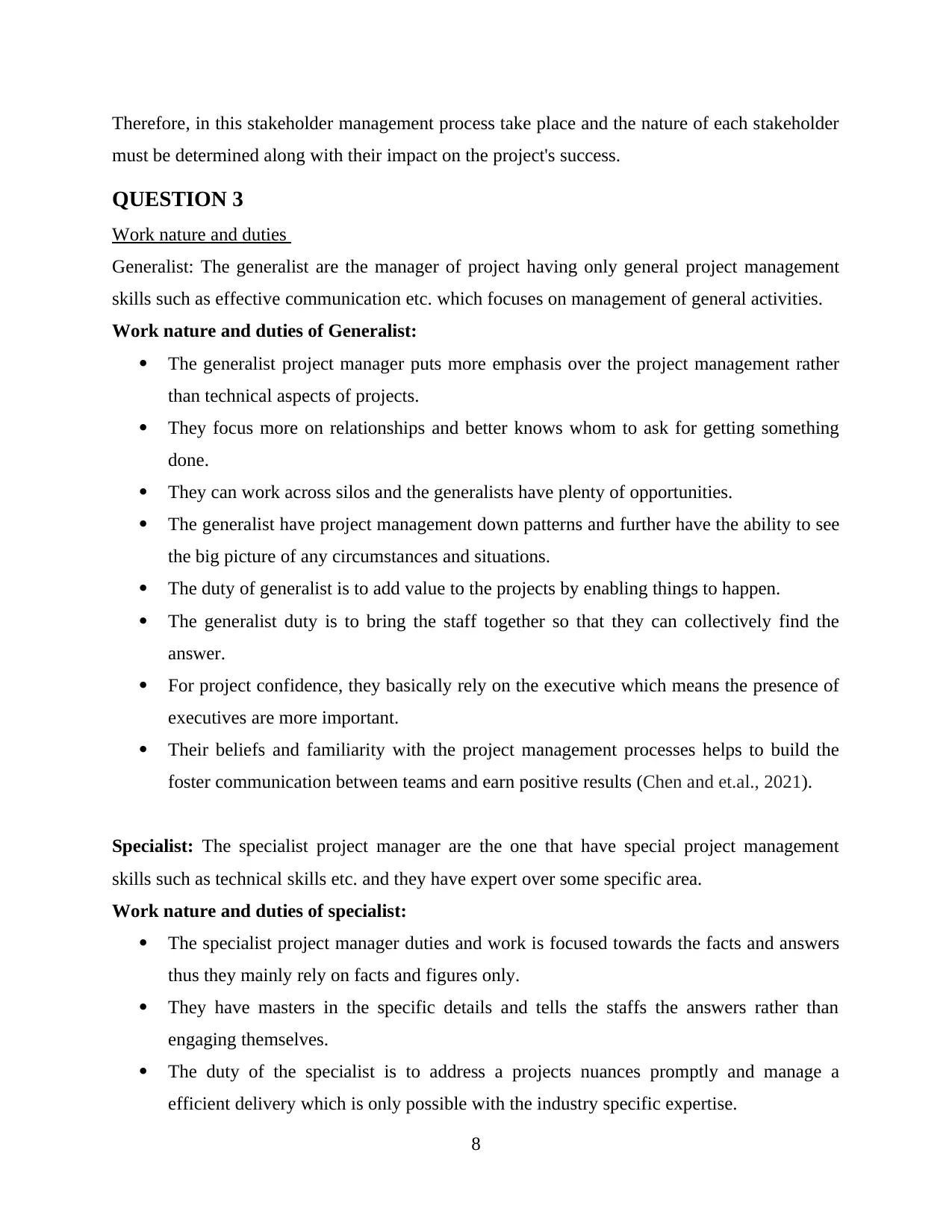
Therefore, in this stakeholder management process take place and the nature of each stakeholder
must be determined along with their impact on the project's success.
QUESTION 3
Work nature and duties
Generalist: The generalist are the manager of project having only general project management
skills such as effective communication etc. which focuses on management of general activities.
Work nature and duties of Generalist:
The generalist project manager puts more emphasis over the project management rather
than technical aspects of projects.
They focus more on relationships and better knows whom to ask for getting something
done.
They can work across silos and the generalists have plenty of opportunities.
The generalist have project management down patterns and further have the ability to see
the big picture of any circumstances and situations.
The duty of generalist is to add value to the projects by enabling things to happen.
The generalist duty is to bring the staff together so that they can collectively find the
answer.
For project confidence, they basically rely on the executive which means the presence of
executives are more important.
Their beliefs and familiarity with the project management processes helps to build the
foster communication between teams and earn positive results (Chen and et.al., 2021).
Specialist: The specialist project manager are the one that have special project management
skills such as technical skills etc. and they have expert over some specific area.
Work nature and duties of specialist:
The specialist project manager duties and work is focused towards the facts and answers
thus they mainly rely on facts and figures only.
They have masters in the specific details and tells the staffs the answers rather than
engaging themselves.
The duty of the specialist is to address a projects nuances promptly and manage a
efficient delivery which is only possible with the industry specific expertise.
8
must be determined along with their impact on the project's success.
QUESTION 3
Work nature and duties
Generalist: The generalist are the manager of project having only general project management
skills such as effective communication etc. which focuses on management of general activities.
Work nature and duties of Generalist:
The generalist project manager puts more emphasis over the project management rather
than technical aspects of projects.
They focus more on relationships and better knows whom to ask for getting something
done.
They can work across silos and the generalists have plenty of opportunities.
The generalist have project management down patterns and further have the ability to see
the big picture of any circumstances and situations.
The duty of generalist is to add value to the projects by enabling things to happen.
The generalist duty is to bring the staff together so that they can collectively find the
answer.
For project confidence, they basically rely on the executive which means the presence of
executives are more important.
Their beliefs and familiarity with the project management processes helps to build the
foster communication between teams and earn positive results (Chen and et.al., 2021).
Specialist: The specialist project manager are the one that have special project management
skills such as technical skills etc. and they have expert over some specific area.
Work nature and duties of specialist:
The specialist project manager duties and work is focused towards the facts and answers
thus they mainly rely on facts and figures only.
They have masters in the specific details and tells the staffs the answers rather than
engaging themselves.
The duty of the specialist is to address a projects nuances promptly and manage a
efficient delivery which is only possible with the industry specific expertise.
8
⊘ This is a preview!⊘
Do you want full access?
Subscribe today to unlock all pages.

Trusted by 1+ million students worldwide
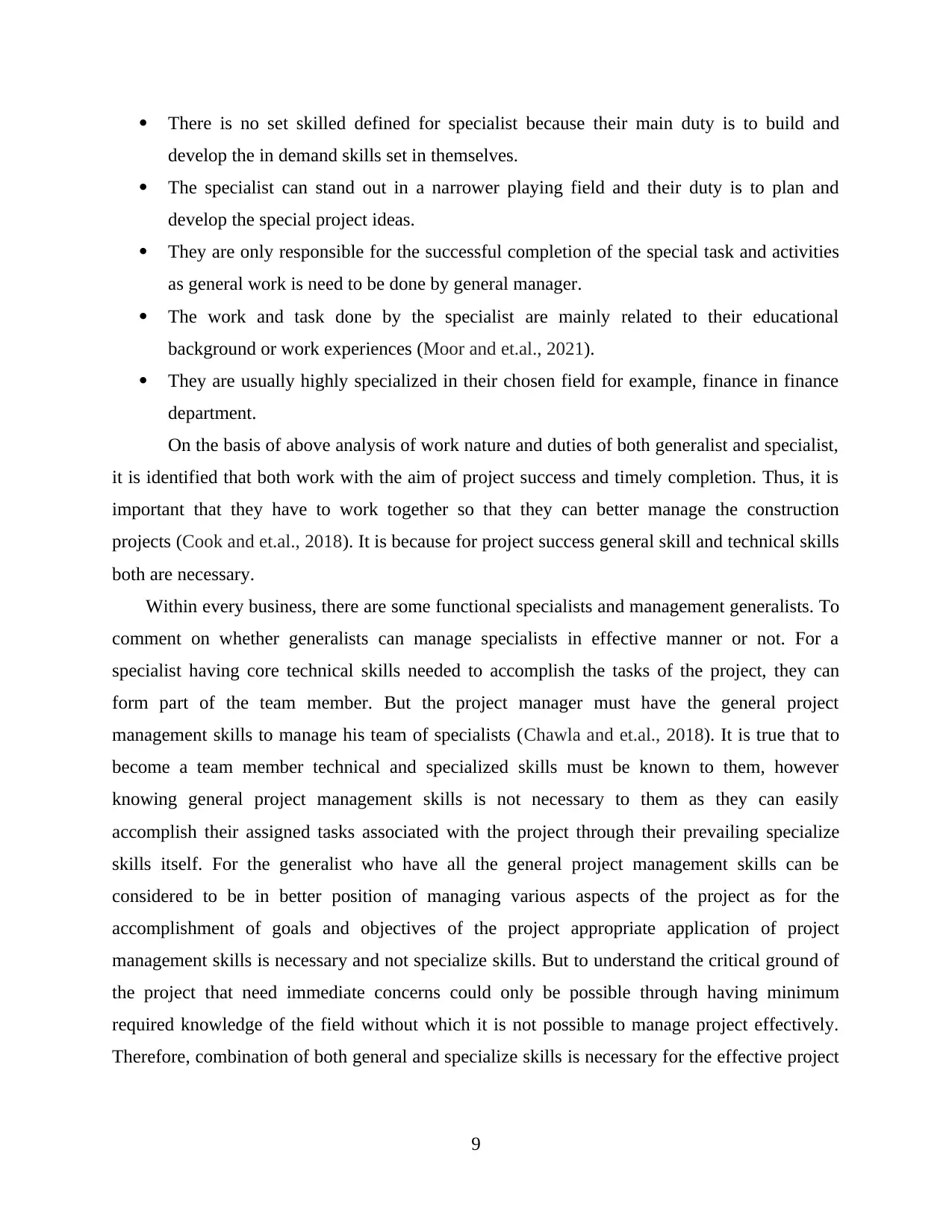
There is no set skilled defined for specialist because their main duty is to build and
develop the in demand skills set in themselves.
The specialist can stand out in a narrower playing field and their duty is to plan and
develop the special project ideas.
They are only responsible for the successful completion of the special task and activities
as general work is need to be done by general manager.
The work and task done by the specialist are mainly related to their educational
background or work experiences (Moor and et.al., 2021).
They are usually highly specialized in their chosen field for example, finance in finance
department.
On the basis of above analysis of work nature and duties of both generalist and specialist,
it is identified that both work with the aim of project success and timely completion. Thus, it is
important that they have to work together so that they can better manage the construction
projects (Cook and et.al., 2018). It is because for project success general skill and technical skills
both are necessary.
Within every business, there are some functional specialists and management generalists. To
comment on whether generalists can manage specialists in effective manner or not. For a
specialist having core technical skills needed to accomplish the tasks of the project, they can
form part of the team member. But the project manager must have the general project
management skills to manage his team of specialists (Chawla and et.al., 2018). It is true that to
become a team member technical and specialized skills must be known to them, however
knowing general project management skills is not necessary to them as they can easily
accomplish their assigned tasks associated with the project through their prevailing specialize
skills itself. For the generalist who have all the general project management skills can be
considered to be in better position of managing various aspects of the project as for the
accomplishment of goals and objectives of the project appropriate application of project
management skills is necessary and not specialize skills. But to understand the critical ground of
the project that need immediate concerns could only be possible through having minimum
required knowledge of the field without which it is not possible to manage project effectively.
Therefore, combination of both general and specialize skills is necessary for the effective project
9
develop the in demand skills set in themselves.
The specialist can stand out in a narrower playing field and their duty is to plan and
develop the special project ideas.
They are only responsible for the successful completion of the special task and activities
as general work is need to be done by general manager.
The work and task done by the specialist are mainly related to their educational
background or work experiences (Moor and et.al., 2021).
They are usually highly specialized in their chosen field for example, finance in finance
department.
On the basis of above analysis of work nature and duties of both generalist and specialist,
it is identified that both work with the aim of project success and timely completion. Thus, it is
important that they have to work together so that they can better manage the construction
projects (Cook and et.al., 2018). It is because for project success general skill and technical skills
both are necessary.
Within every business, there are some functional specialists and management generalists. To
comment on whether generalists can manage specialists in effective manner or not. For a
specialist having core technical skills needed to accomplish the tasks of the project, they can
form part of the team member. But the project manager must have the general project
management skills to manage his team of specialists (Chawla and et.al., 2018). It is true that to
become a team member technical and specialized skills must be known to them, however
knowing general project management skills is not necessary to them as they can easily
accomplish their assigned tasks associated with the project through their prevailing specialize
skills itself. For the generalist who have all the general project management skills can be
considered to be in better position of managing various aspects of the project as for the
accomplishment of goals and objectives of the project appropriate application of project
management skills is necessary and not specialize skills. But to understand the critical ground of
the project that need immediate concerns could only be possible through having minimum
required knowledge of the field without which it is not possible to manage project effectively.
Therefore, combination of both general and specialize skills is necessary for the effective project
9
Paraphrase This Document
Need a fresh take? Get an instant paraphrase of this document with our AI Paraphraser
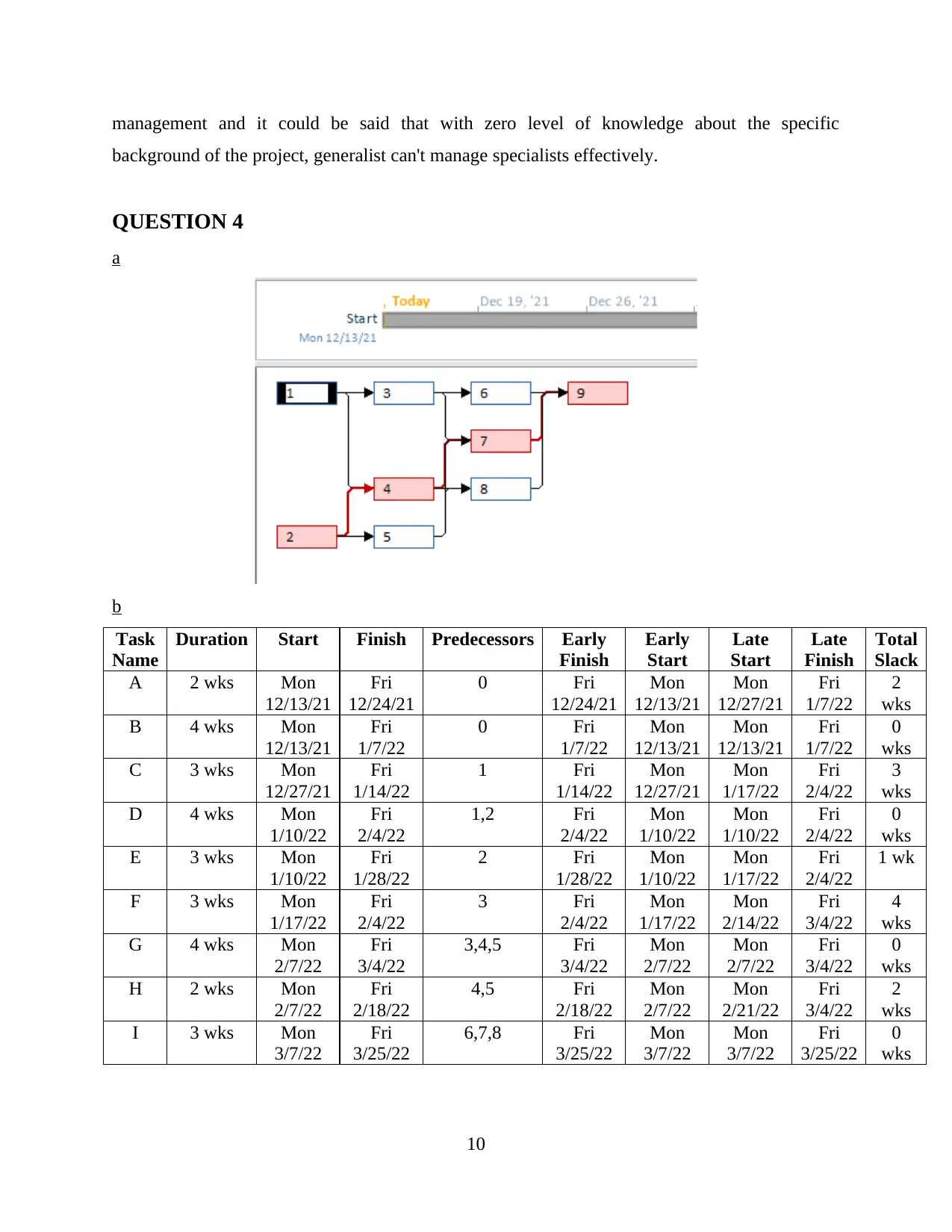
management and it could be said that with zero level of knowledge about the specific
background of the project, generalist can't manage specialists effectively.
QUESTION 4
a
b
Task
Name
Duration Start Finish Predecessors Early
Finish
Early
Start
Late
Start
Late
Finish
Total
Slack
A 2 wks Mon
12/13/21
Fri
12/24/21
0 Fri
12/24/21
Mon
12/13/21
Mon
12/27/21
Fri
1/7/22
2
wks
B 4 wks Mon
12/13/21
Fri
1/7/22
0 Fri
1/7/22
Mon
12/13/21
Mon
12/13/21
Fri
1/7/22
0
wks
C 3 wks Mon
12/27/21
Fri
1/14/22
1 Fri
1/14/22
Mon
12/27/21
Mon
1/17/22
Fri
2/4/22
3
wks
D 4 wks Mon
1/10/22
Fri
2/4/22
1,2 Fri
2/4/22
Mon
1/10/22
Mon
1/10/22
Fri
2/4/22
0
wks
E 3 wks Mon
1/10/22
Fri
1/28/22
2 Fri
1/28/22
Mon
1/10/22
Mon
1/17/22
Fri
2/4/22
1 wk
F 3 wks Mon
1/17/22
Fri
2/4/22
3 Fri
2/4/22
Mon
1/17/22
Mon
2/14/22
Fri
3/4/22
4
wks
G 4 wks Mon
2/7/22
Fri
3/4/22
3,4,5 Fri
3/4/22
Mon
2/7/22
Mon
2/7/22
Fri
3/4/22
0
wks
H 2 wks Mon
2/7/22
Fri
2/18/22
4,5 Fri
2/18/22
Mon
2/7/22
Mon
2/21/22
Fri
3/4/22
2
wks
I 3 wks Mon
3/7/22
Fri
3/25/22
6,7,8 Fri
3/25/22
Mon
3/7/22
Mon
3/7/22
Fri
3/25/22
0
wks
10
background of the project, generalist can't manage specialists effectively.
QUESTION 4
a
b
Task
Name
Duration Start Finish Predecessors Early
Finish
Early
Start
Late
Start
Late
Finish
Total
Slack
A 2 wks Mon
12/13/21
Fri
12/24/21
0 Fri
12/24/21
Mon
12/13/21
Mon
12/27/21
Fri
1/7/22
2
wks
B 4 wks Mon
12/13/21
Fri
1/7/22
0 Fri
1/7/22
Mon
12/13/21
Mon
12/13/21
Fri
1/7/22
0
wks
C 3 wks Mon
12/27/21
Fri
1/14/22
1 Fri
1/14/22
Mon
12/27/21
Mon
1/17/22
Fri
2/4/22
3
wks
D 4 wks Mon
1/10/22
Fri
2/4/22
1,2 Fri
2/4/22
Mon
1/10/22
Mon
1/10/22
Fri
2/4/22
0
wks
E 3 wks Mon
1/10/22
Fri
1/28/22
2 Fri
1/28/22
Mon
1/10/22
Mon
1/17/22
Fri
2/4/22
1 wk
F 3 wks Mon
1/17/22
Fri
2/4/22
3 Fri
2/4/22
Mon
1/17/22
Mon
2/14/22
Fri
3/4/22
4
wks
G 4 wks Mon
2/7/22
Fri
3/4/22
3,4,5 Fri
3/4/22
Mon
2/7/22
Mon
2/7/22
Fri
3/4/22
0
wks
H 2 wks Mon
2/7/22
Fri
2/18/22
4,5 Fri
2/18/22
Mon
2/7/22
Mon
2/21/22
Fri
3/4/22
2
wks
I 3 wks Mon
3/7/22
Fri
3/25/22
6,7,8 Fri
3/25/22
Mon
3/7/22
Mon
3/7/22
Fri
3/25/22
0
wks
10
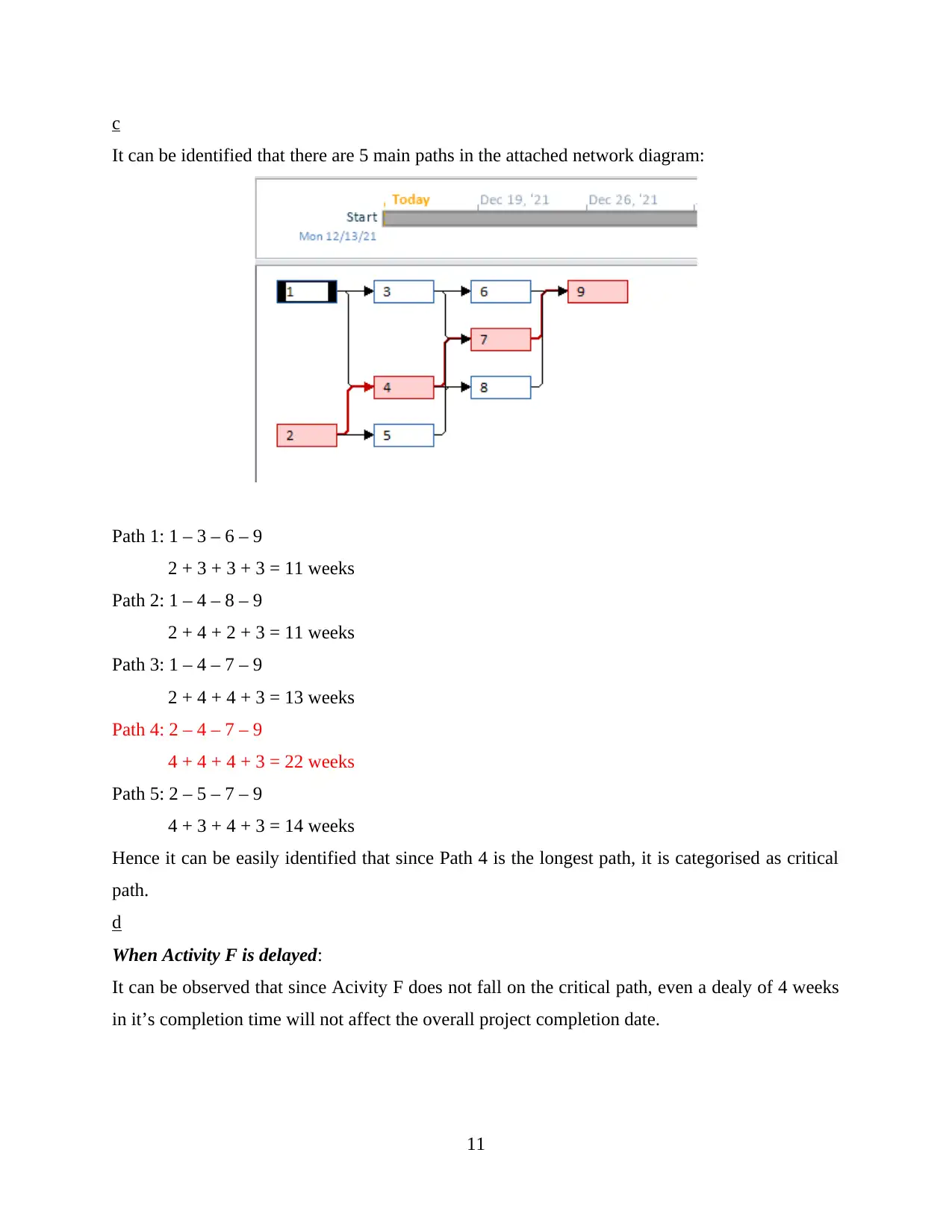
c
It can be identified that there are 5 main paths in the attached network diagram:
Path 1: 1 – 3 – 6 – 9
2 + 3 + 3 + 3 = 11 weeks
Path 2: 1 – 4 – 8 – 9
2 + 4 + 2 + 3 = 11 weeks
Path 3: 1 – 4 – 7 – 9
2 + 4 + 4 + 3 = 13 weeks
Path 4: 2 – 4 – 7 – 9
4 + 4 + 4 + 3 = 22 weeks
Path 5: 2 – 5 – 7 – 9
4 + 3 + 4 + 3 = 14 weeks
Hence it can be easily identified that since Path 4 is the longest path, it is categorised as critical
path.
d
When Activity F is delayed:
It can be observed that since Acivity F does not fall on the critical path, even a dealy of 4 weeks
in it’s completion time will not affect the overall project completion date.
11
It can be identified that there are 5 main paths in the attached network diagram:
Path 1: 1 – 3 – 6 – 9
2 + 3 + 3 + 3 = 11 weeks
Path 2: 1 – 4 – 8 – 9
2 + 4 + 2 + 3 = 11 weeks
Path 3: 1 – 4 – 7 – 9
2 + 4 + 4 + 3 = 13 weeks
Path 4: 2 – 4 – 7 – 9
4 + 4 + 4 + 3 = 22 weeks
Path 5: 2 – 5 – 7 – 9
4 + 3 + 4 + 3 = 14 weeks
Hence it can be easily identified that since Path 4 is the longest path, it is categorised as critical
path.
d
When Activity F is delayed:
It can be observed that since Acivity F does not fall on the critical path, even a dealy of 4 weeks
in it’s completion time will not affect the overall project completion date.
11
⊘ This is a preview!⊘
Do you want full access?
Subscribe today to unlock all pages.

Trusted by 1+ million students worldwide
1 out of 15
Related Documents
Your All-in-One AI-Powered Toolkit for Academic Success.
+13062052269
info@desklib.com
Available 24*7 on WhatsApp / Email
![[object Object]](/_next/static/media/star-bottom.7253800d.svg)
Unlock your academic potential
Copyright © 2020–2025 A2Z Services. All Rights Reserved. Developed and managed by ZUCOL.





